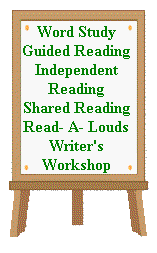TEACHING STYLES AND TECHNIQUES
Balanced Literacy

Word Study: Word study provides students with the opportunity to become aware of sounds in words and how they relate to symbols in written language. Here is an example lesson that contains Word Study
Guided Reading:Guided reading provides an opportunity for students to practice reading strategies and take responsibility for their reading. Teachers listen and make decisions on the instructional needs of each student. Here is an example lesson that contains Guided Reading.
Shared Reading: Shared Reading with and enlarged text or a text everyone can see provides an opportunity for all students to successfully participate in reading. Each student, regardless of reading level, can be engaged in the reading process. Here is and example lesson that contains Shared Reading.
Read-A-Louds: Through reading aloud students understand that the language of books is different from spoken language, they develop understanding of the patterns and structures of written language, learn new words and ideas, and learn about and locate models of particular genres. Here is an example lesson that contains a Read-A-Loud.
Independant Reading: Independant reading by students gives them opportunities to practice the strategies they have learned in word study, guided reading, shared reading and read alouds. Teachers provide guidance with book choices, tailor teaching to meet individual needs and meet with individuals to monitor progress. Books from a range of levels are available in the classroom. Here is an example lesson on Developing Reading Plans to Support Independant Reading
Writer's Workshop: Types of Writing:
-Modeled:Teachers demonstrate strategies and model the writing process and through the process adds, revises, asks questions and clarifies purpose. Here is an example lesson for Modeled Writing (The Very Lonely Firefly writing workshop)
-Shared: The students and teacher share the task of writing. The writing comes from the students' thoughts and ideas. Teachers identify and discuss with students the conventions, structures and language features of written text. Here is an example lesson for Shared Writing
-Guided: Guided writing provides an opportunity to work with groups of students or an individual student on effective writing strategies as determined through teacher observation of student behaviors and work. This is an opportunity to develop a student's independance and ability to self-monitor own learning of writing strategies and skills. Here is an example lesson for Guided Writing (need to finish)
-Independant: Independant writing provides an opportunity to practice using the writing strategies they have learned. Students are encouraged to write for authentic purposes and use a variety of styles. Teachers conference with students and encourage them to publish their work. Here is an example lesson for Independant Writing (still need to fix the format of this lesson The Very Lonely Firefly
Differentiating Instruction

Differentiating Instruction is "shaking up" what goes on in my classroom so that students have multiple options for taking in information, making sense of ideas, and expressing what they've learned.
Co-Teaching

Co-Teaching in my classroom is where two teachers share the responsibility of teaching the entire class, with the outlook of every student is our student.
Sharing our speciality skill set with each other in order to present lessons in the most beneficial way for our students.
We see each other as equals and share a common goal and believe that co-teaching is a better method of teaching for our students to achieve success.
Co-Teaching contains 5 models for teaching: A lesson is included for each text link below.
Please select a model to see an example lesson.
1. One Teach/One Observe / One Teach/One Assist
2. Station Teaching
3. Parallel Teaching
4. Alternative Teaching
5. Team Teaching
